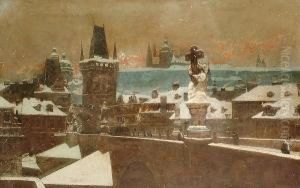Franta Vysekal Paintings
Frantisek (Franta) Vysekal was a Czech-American painter known for his involvement in the Southern California art scene during the early 20th century. Born on March 23, 1882, in Lounovice pod Blanikem, Bohemia (now the Czech Republic), he immigrated to the United States in 1901, initially settling in Chicago. There, he began to pursue his artistic training, studying at the Art Institute of Chicago under notable instructors such as John Vanderpoel.
After his education, Vysekal continued to develop his artistic style, which was influenced by the prevailing American Realism of the time, as well as by European Modernism, which he became acquainted with through various exhibitions and his own travels. In 1914, he relocated to Los Angeles, California, where he would become a significant figure in the local art community. He taught at the Art Students League of Los Angeles and later at the Otis Art Institute, where his pedagogy would influence a generation of West Coast artists.
Vysekal was also a founding member of the influential Group of Eight, a collection of Los Angeles-based painters who exhibited together in the 1920s and sought to promote modernist art in Southern California. The group, which included artists like Clarence Hinkle, Henri De Kruif, and Edouard Vysekal, Franta's wife, was known for their diverse styles and commitment to exhibiting avant-garde work. Through these exhibitions, Vysekal helped to foster a more cosmopolitan art scene in Los Angeles.
Throughout his career, Vysekal's work evolved, showing influences from Impressionism, Post-Impressionism, and Cubism. He was known for his portraits, landscapes, and still lifes, often marked by a bright color palette and a dynamic application of paint. His artwork was exhibited widely during his lifetime, including shows at the Los Angeles County Museum of Art, the Pennsylvania Academy of the Fine Arts, and the Art Institute of Chicago.
Franta Vysekal's contributions to the art world were cut short when he died on October 8, 1939, in Los Angeles. Despite his relatively early death, his legacy endured through his influence on his students and his role in shaping the Southern California art scene. Today, his works are part of several museum collections, and he is remembered as a pivotal figure in the development of modern art in the United States.
